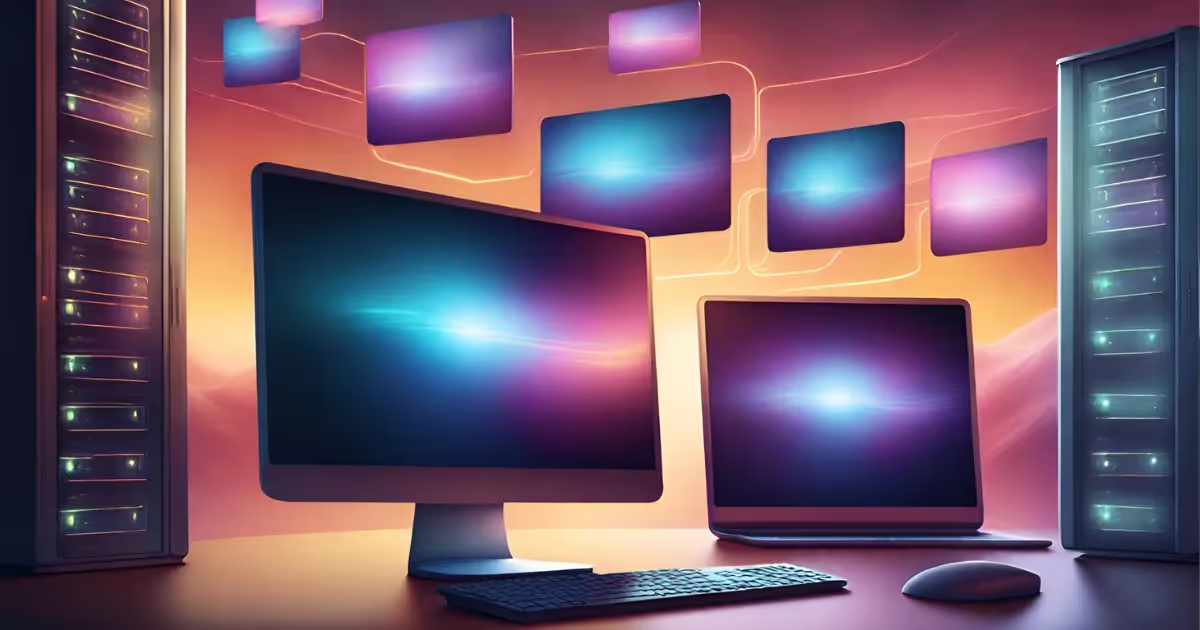
Many businesses are switching towards virtual desktops due to the inherent flexibility and practicality that this setup provides in comparison to traditional formats.
Are virtual desktops a cost-effective option and is it worth making the switch over from typical desk-based PCs connected via servers?
How do Virtual Desktops Work?
Virtual desktops host a desktop environment from a central server, running specific desktop images from a virtual machine (VM). These are then delivered to the end user’s device over the network. These devices could be office computers, tablets, and mobile devices.
This means that any normal business system and applications can be replicated and delivered to staff in any location, with the overall effect being much the same as accessing their computer at work.
Advantages of Virtual Desktops
The main advantages of VDI in general are cost savings, no need for expensive equipment or hardware, they are more scalable and flexible than traditional desktop setup and for most job types, more practically functional in terms of being able to access, share and store data from any location or device.
Virtual desktops also provide additional security and a more centralised management hub to apply fixes and updates, making overall transparency of the system better and making any required changes much easier.
What are the Practical Benefits of Virtual Desktops?
Scalability and Flexibility
Using virtual desktops it is much easier to scale up or down operations as needed, without the need to have any equipment or infrastructure delivered or set up.
For example, if you have another 20 workers enter your workforce for a limited project of around one month, providing them all with real desktops can be something of a headache for most businesses.
Firstly, where will you put all these new team members where they won’t be getting under everyone’s feet, will there be enough physical space in the office for them or will you need to rent a new office space?
You will need all the typical office furniture—desks for them to work on and chairs to sit on—plus the computers themselves and all the network cabling and everything that goes with it.
Conversely, with a virtual desktop setup in place, you would just have a pool of available resources—say 100 virtual desktops that can be accessed by your users—if you need more resources and virtual desktops, you just change the number from 100 to 120 and it is as simple as that.
By simply upgrading the amount of virtual desktop sessions you have available in the resources pool, your staff can then access an identical version of the company intranet or normal interface, with all the typical applications and customisations they would get running their normal office PC.
Reduced Costs
Apart from the logistical difficulties of getting everything delivered and working correctly, there is a significant cost that will be associated with buying all the expensive new equipment that would normally be required to set up a new project, move to a new office space or add more workers to the team.
According to Servcorp, in London, it would cost on average £700 per person for a serviced office space each month. So for a team of 20, you would be looking at around £14,000 per month or £168,000 per year.
Of course, then there would be the equipment costs to pay on top of that. All of the computers, servers, and network equipment can quickly start to mount up. For a team of 20 employees, it could cost around £40,000 in total for a basic setup with desks, chairs, and computers.
Facilitates Remote Working in Cloud Environments
One of the key advantages of virtual desktop solutions is that they are ideally catered to remote work using cloud environments.
If you are working on-site or working from home, it may be difficult to get all the computing power plus the applications you need and all the data and work files you need to get your job done.
For example, if you are on a building site it is not exactly easy to deliver a desktop PC and servers, with all your applications you need ready to go.
With virtual desktops, working remotely through the cloud is made much more straightforward and practical.
Wherever the employee is located, as soon as they log onto the virtual desktop infrastructure they are presented with a simulated version of their normal office workspace.
If, for example, you are an architect or graphic artist dealing with processor-hungry images, schematics, and three-dimensional models that require top-end graphics cards to manipulate them, you do not need to worry about the processor or GPU power of your home setup being adequate as you would not be using your own device’s power to run the applications but drawing from centralised and remotely operated virtual machines that power all the software and systems for you.
With virtual desktops, you are also presented with a unified company image or brand and similar to the effect of wearing a company uniform, it lets you know you are at work and you are part of a collective team with a shared identity through the business branding and logos.
Contact Lyon Tech
At Lyon Tech, we provide businesses with cost-effective virtual desktop solutions that allow them to streamline their working processes and shift towards a fully remote or cloud-based environment with ease.
Our virtual desktop services provide businesses with an option that is more cost-effective, scalable, flexible, and catered to the needs of their remote working requirements.
If you would like to know more about how virtual desktops could benefit your business, get in touch with our friendly advisors today.


